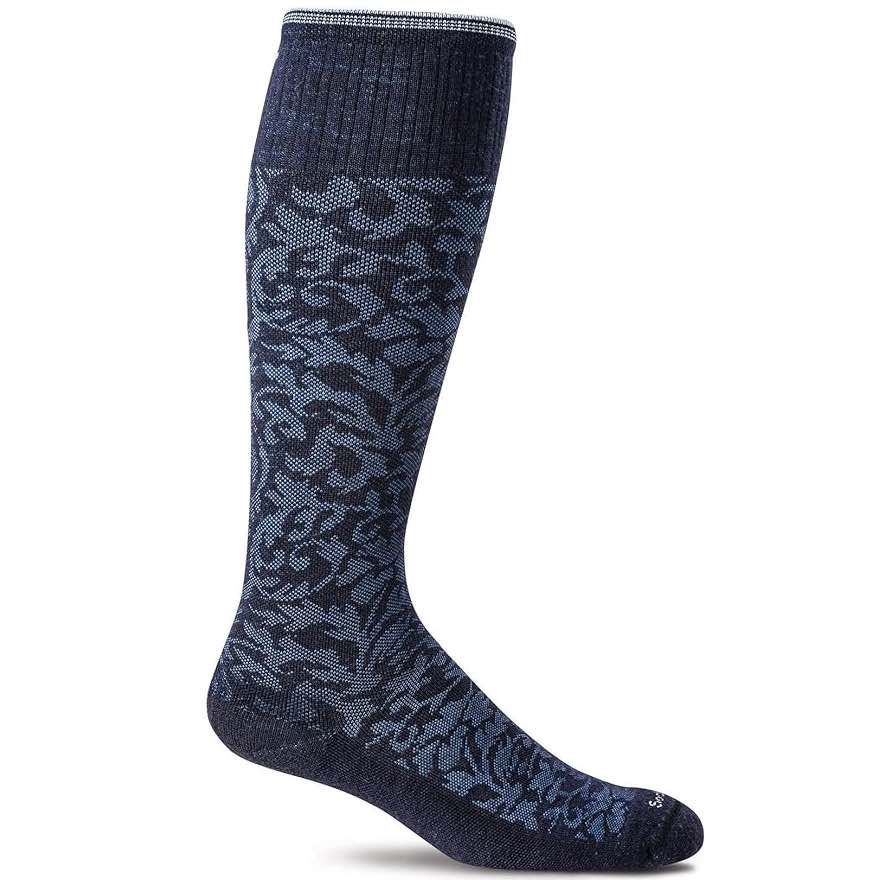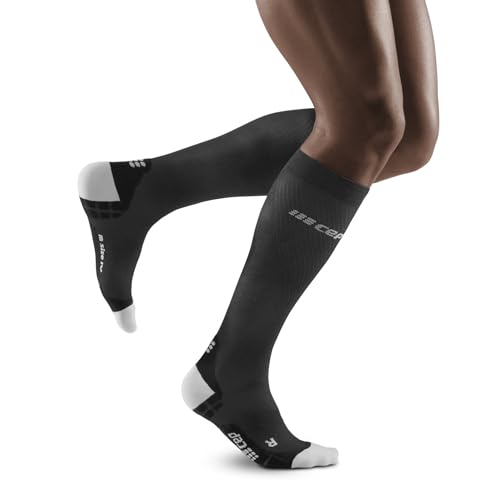People who stand or sit for extended periods often experience swelling and pain in their legs, which can potentially lead to varicose veins. That’s where compression stockings come in handy.
These tighter-than-average socks are specifically designed to alleviate symptoms of varicose veins. Starting tight at the ankle and gradually lessening in pressure up the leg, they help reduce fatigue, swelling, and pain in the legs.
What do Compression Stockings do
When people stand for extended periods or face issues with their venous valves, gravity hinders blood flow up the veins. This can result in varicose veins and discomfort in the lower limbs.
By exerting the right amount of external pressure through compression stockings, blood from the calf veins is encouraged to flow back up to the thigh. This not only eases the symptoms of varicose veins but also helps treat swelling. Hence, these stockings serve as a form of physical therapy.
For those diagnosed with certain conditions like diabetes, phlebitis, or leg ulcers, these stockings are prescribed.
Beyond folks with specific health issues, compression stockings are great for everyday wear too. They’re perfect for nurses, retail workers, travelers spending long hours in car or plane seats, and even runners, helping improve blood circulation, relieve fatigue, and bounce back to full energy faster.
How Compression Stockings Work
These stockings exert external pressure on the legs, preventing blood from pooling in the calves. They’re not about stopping arterial blood flow to the lower legs but rather aiding venous blood to flow back up.
Designed to apply maximum pressure at the ankle and gradually decrease up to the knee, this gradient pressure promotes blood return to the heart, alleviating strain on the venous valves, thus mitigating varicose veins. Continuous blood flow also means reduced chances of clot formation.
Although great for varicose veins, be cautious not to wear stockings that are too tight, especially at night. Breathability of the material matters too – you don’t want to block out heat or trap sweat, as that could lead to skin issues. Most are tested for breathability against the ISO 9237 standard.
Who Should Wear Compression Stockings?
Many athletes rock compression stockings and sleeves on their legs and arms. The idea is that better blood flow during activity aids muscle oxygenation and support helps prevent tissue damage.
Improved blood and lymph circulation is believed to quicken muscle recovery. While research hasn’t really proven that it enhances athletic performance, there’s some evidence that post-workout recovery can benefit. But hey, if they feel like it gives them an edge (a confidence boost never hurts), why not?
Folks who’d truly benefit from compression stockings include:
- Those with deep vein thrombosis, varicose veins, or diabetes, or at risk of these conditions;
- Recent surgery patients;
- People who’re bedridden or have limited leg mobility;
- Those on their feet all day at work;
- Athletes;
- Expecting moms;
- Folks spending a lot of time on planes, like pilots or long-haul travelers.
Types of Compression Stockings
Just like sleeves, compression stockings come in various lengths – from ankle-length to below the knee, and you can even get thigh-highs or full-length compression tights.
They’re categorized by pressure levels, measured in mmHg (millimeters of mercury):
- Light pressure: Less than 20 mmHg. Perfect for long-haul travelers, these can be easily found online or at local drugstores.
- Moderate pressure: 20-30 mmHg. Ideal for folks with deep vein thrombosis or varicose veins, helping manage swelling and pain.
- Moderate-to-high pressure: 30-40 mmHg. Best for those with significant pain or swelling.
- Firm pressure: 40-50 mmHg. Suited for those with severe venous issues or a history of blood clots.
A popular choice among compression stockings are graduated ones, where the tightness varies based on the leg’s location: snug at the ankle and gradually looser up the leg.
There are also anti-thrombotic stockings specifically designed for post-surgery patients and those confined to bed for long durations. They help maintain blood circulation and significantly reduce the chances of severe swelling.
Top 9 Compression Stocking Recommendations
LEVSOX
The best compression stockings should fit just right, feel comfortable, provide the right amount of support, and be affordable enough for you to buy multiple pairs. The LEVSOX 20-30mmHg compression stockings for both men and women tick all these boxes, making them our top pick.
Their fit, feel, support, and value are spot-on. They’re easy to wear and fit as snugly as leggings or tights, with noticeable arch support and an overall great wearing experience. The fabric is breathable, silky smooth, and holds up well after multiple washes.
LEVSOX offers various patterns and sizes, including a plus-sized version. While the designs are more feminine and easy to match with outfits, men are limited to the classic black without much variety in design.
Comrad
Shopping for Comrad stockings is straightforward as they’re categorized by pressure level or purpose. Their 15-20 mmHg knee-high compression stockings provide a ton of stretchy comfort, making them versatile for various activities and body types, from everyday wear to travel, sports, workouts, and recovery.
In terms of fit and support, Comrad socks are snug and stay in place, ensuring your legs feel supported and energized during prolonged sitting periods, including flights. However, after about eight hours, you’d want to take them off to let your feet breathe.
Nevertheless, the material is still soft and durable, retaining its shape through wear and washing.
Physix Gear Sport
Whether you’re catching a long flight or going for a morning run, these soft, breathable socks ensure comfort while reducing swelling and leg fatigue. With a 20-30 mmHg pressure range, they provide excellent support for pregnant women, athletes, and anyone seeking a snug fit without feeling too constrained.
Though tight, they’re not a challenge to wear, and they don’t slide down during the day. They’re particularly friendly for folks with shorter calves, as regular socks often bunch at the knee, but these won’t. Note that these socks are hand-wash only; machine washing might compromise their compression.
Physix Gear Sport also produces calf compression sleeves and elbow compression sleeves.
PRO Compression
Pro Compression manufactures compression socks, calf sleeves, and even arm compression sleeves. You can browse styles based on sock length or pressure level, ranging from 10-35 mmHg. The site offers tons of styles and sizes, and PRO Compression stockings are easy to wear while still offering ample support.
The Marathon style, ending just below the knee, stands out for its comfort. For those tackling hours of chores, gardening, errands, dog-walking, or workouts, these socks ease pain and reduce muscle soreness.
Dr. Scholl’s
As a foot care expert, Dr. Scholl’s is an affordable entry-level choice. If you’re concerned about compression stockings feeling too tight, Dr. Scholl’s gradient compression socks can serve as your introductory pair. These offer a light 8-15 mmHg pressure level, which is subtle yet effective. The toe seams are smooth, ensuring no awkward feelings at the toes.
However, they might feel a tad light on ankle compression for some, and while they’re good for mild pain relief (and are budget-friendly), those with severe swelling and pain might need a more specialized brand.
CharmKing
For nurses, one of the most on-the-go professions that require leg relief, Charmking compression stockings bring a burst of fun with their vibrant and colorful patterns while providing the necessary leg support. They offer medium pressure, aiming to alleviate leg fatigue and swelling.
Made with breathable, moisture-wicking fabric, these socks ensure your feet stay dry and comfortable all day. They come in packs of eight, offering a convenient rotation, and are an incredible deal at just three dollars a pair!
Zensah
Made in Italy, Zensah Tech+ Compression Socks soothe post-run muscle aches and are perfect for runners. They come in four sizes, with a 200 needle count for extra durability and density, yet they remain lightweight, moisture-wicking, and warm.
These socks feature a seamless toe design to prevent chafing and blisters. The graduated compression in the calf area also helps folks like nurses who are on their feet all day feel less fatigued and is beneficial for travelers to minimize leg swelling. The anatomically designed socks have specific right and left foot construction to ensure a perfect fit.
CEP
While CEP compression socks aren’t the cheapest, they’re highly specialized and come in just about every style imaginable, including high socks, leg sleeves without foot coverage, and no-show short socks.
CEP’s ultra-light compression socks are highly recommended. They’re 25% lighter than their regular ones, making them comfy even for those who tend to sweat a bit more. Seamless toe enclosure and lightweight cushioning ensure sock comfort without compromising shoe fit.
Made of nylon, elastane, and polypropylene, they’re moisture-wicking and minimize friction. CEP’s socks have distinct right and left foot constructions, so ensure you’re wearing them on the correct feet.
Of course, the obvious downside to CEP compression socks is their price tag.
Sockwell
For genuinely high-quality compression socks, look no further than Sockwell. Crafted from a blend of 32% Merino wool, 31% bamboo rayon, 32% stretch nylon, and 5% spandex, they offer thermoregulation and moisture management, ensuring dry, comfy feet.
Sockwell offers unique patterns like entwining leaves, alternating chevrons, and regal blue damask, as well as sophisticated solids. Their 15-20 mmHg socks provide four zones of graduated compression to boost circulation, reduce swelling, and relieve fatigue.
If you’re looking for more substantial compression due to poor blood circulation, try the Sockwell Elevation. These socks offer graduated compression ranging from 20-30 mmHg when most budget-friendly socks cap at 20 mmHg.

A lot of patterns to choose from
For those seeking lighter compression for daily wear, Sockwell Lifestyle Compression series comes with tons of cute patterns at a 15-20 mmHg pressure level.
How to Choose Compression Socks
- Know What You Need: First, understand your needs and decide which type of compression sock is right for you. If you’re looking to boost leg circulation or reduce fatigue, light to medium compression socks from supermarkets, drugstores, or online will suffice.
- Ask Your Doctor: For medical reasons, such as preventing blood clots or post-surgery recovery, you might need anti-thrombosis socks. Always consult with a doctor or healthcare provider before purchasing to ensure your chosen socks meet your requirements. Medically prescribed compression socks might be covered by insurance.
- Choose the Length: Knee-high compression socks suit most for everyday wear. Thigh-high socks are better for those with thicker calf muscles. Compression tights that reach the waist are a popular choice among athletes.
- Try ‘Em Out: If it’s your first time wearing compression socks, it might take a bit to get used to. If they feel uncomfortable, feel free to take them off. You don’t have to wear them all day.
- Daily Care: Wearing compression socks is just one part of daily care. Drink plenty of water, maintain a low-salt diet, and move your legs frequently. Balance between sitting and standing.
The Right Way to Wear Compression Socks
Compression socks aren’t your typical stockings; they’re snug-fitting. This means you can’t just yank them on like regular socks or roll them up like tights. Here’s the correct way to wear:
- Start by reaching into the sock and turning it inside out, up to the heel. Using one hand, gently slide down inside the sock and grab the toe area, pulling it inwards until it forms a pouch around the heel.
- With both hands, smoothly slide the sock over your toes, pulling it back to your heel, making sure it aligns properly. Adjust the toe area to ensure a snug fit.
- Grip the rolled portion of the sock and gently unroll it up over your ankle and smoothly up your calf.
- Slowly continue to pull the sock up to just below your knee, smoothing out any wrinkles or bunches as you go, ensuring it lays flat against your leg.
- For knee-high compression socks, after confirming they fit snugly around the calf, gently unroll the rest, pulling it smoothly up to the thigh. Ensure the sock sits comfortably and evenly on your thigh.
- For full-length compression stockings, once you’ve confirmed a snug fit around the thighs, smoothly pull the waist portion up and adjust so it fits comfortably around your waist, smoothing out any wrinkles.
Disclosure: We are an Amazon Associate. Some links on this website are affiliate links, which means we may earn a commission or receive a referral fee when you sign up or make a purchase through those links.




















Leave a Reply